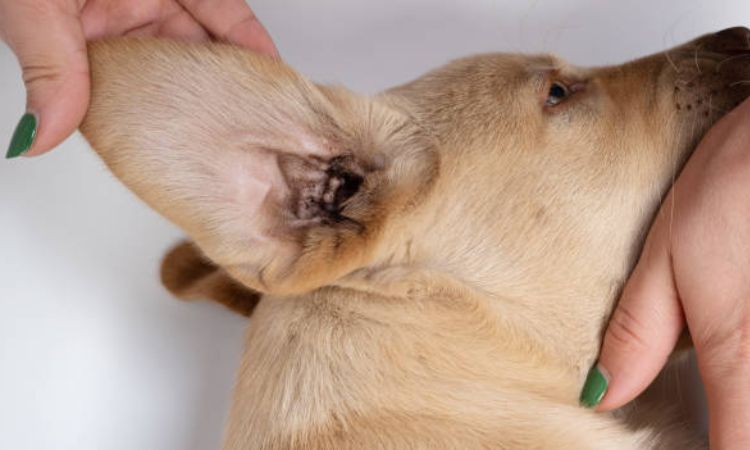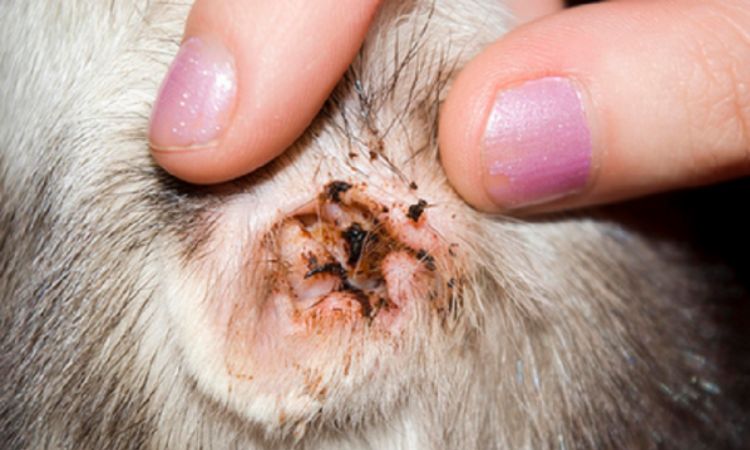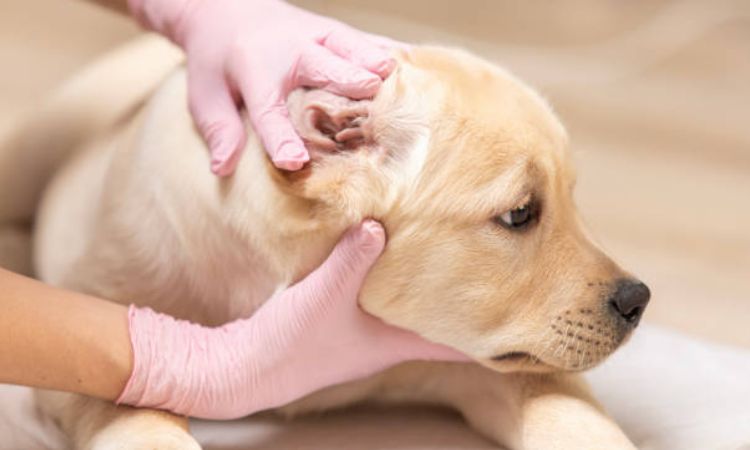Have you noticed a dark or brown discharge coming from your dog’s ears—sometimes sticky and moist, other times dry and flaky? Does it have an unusual smell? These signs can help you and your veterinarian identify the problem and find the right treatment. Follow Nexus-pets to learn effective ways to manage brown discharge caused by dog ear infections.

Causes of Dog Ear Infections Leading to Brown Discharge
Brown discharge in a dog’s ear usually indicates an underlying infection or irritation. Several factors contribute to this condition, often involving an imbalance of microorganisms or physical irritants that trigger inflammation and discharge.
One common cause is the overgrowth of yeast, which thrives in warm, moist environments such as inside a dog’s ear canal, especially in breeds with floppy ears that trap moisture. This yeast overgrowth leads to a greasy, brownish discharge and often a strong odor.
Bacterial infections frequently accompany or follow yeast infections. Bacteria proliferate when the ear’s natural defenses are disrupted, causing pus-like or discolored discharge and inflammation. These infections can be primary or secondary to other ear problems.
Additionally, allergies whether to food, environmental factors, or parasites—can cause itching and inflammation that lead to excessive wax production and ear infections. Moisture trapped in the ear, often from swimming or bathing, worsens the problem by creating an ideal environment for microbes.
Diagnosis
Diagnosing ear problems in dogs—especially when brown discharge is present—requires a thorough veterinary examination to accurately identify the cause and guide effective treatment.
The first step typically involves an otoscopic inspection, where the veterinarian uses an ear scope to closely examine the ear canal and eardrum. This allows them to assess inflammation, the presence of discharge, foreign bodies, or any structural abnormalities.
Next, the veterinarian will collect samples of the ear discharge or debris for laboratory analysis. Microscopic examination and culture testing help determine the specific type of infection, which may include:
- Yeast infection: Commonly caused by Malassezia species, characterized by greasy, brown discharge with a distinctive odor.
- Bacterial infection: May involve Gram-positive or Gram-negative bacteria, often producing pus-like discharge and a foul smell.
- Mixed infection: A combination of yeast and bacteria, which can complicate symptoms and treatment.
Additionally, veterinarians will investigate any underlying factors contributing to recurrent or chronic ear infections, such as:
- Food or environmental allergies
- Anatomical predispositions like floppy ears or narrow ear canals
- Improper or excessive ear cleaning
- Underlying health issues such as immunodeficiency or endocrine disorders (e.g., hypothyroidism)
- Ear parasites like ear mites
Identifying the exact nature of the infection and any predisposing causes enables the veterinarian to tailor an effective treatment plan, reduce the risk of recurrence, and ensure long-term ear health for your dog.

Treatment Options
Topical Treatments
Topical therapies play a crucial role in managing ear infections in dogs. Before applying any medication, it’s important to thoroughly clean the ear canal using a veterinarian-approved ear cleaner to remove wax, debris, and discharge. This preparation ensures that the medication can work effectively. Common topical treatments include ear drops or ointments containing antifungal, antibiotic, or steroid ingredients designed to combat infection and reduce inflammation. Proper technique is essential: always clean the ear first, then apply medication carefully to avoid damaging the ear canal.
Oral Medications
For more severe or persistent infections, oral medications may be prescribed by your veterinarian. Antibiotics or antifungal drugs taken by mouth can help eliminate deeper infections that topical treatments alone cannot reach. Additionally, anti-inflammatory medications may be recommended to alleviate pain and swelling, improving your dog’s comfort during recovery. These systemic treatments should be used under veterinary supervision to monitor for potential side effects.
Home Care and Supportive Remedies
Ongoing care at home is vital to prevent recurrence and support healing. Regular ear cleaning with vet-approved solutions helps maintain a healthy environment inside the ears. Some owners may also use natural adjuncts such as diluted apple cider vinegar or coconut oil to soothe irritation, though these should never replace prescribed treatments. It’s especially important to thoroughly dry your dog’s ears after swimming or bathing to avoid moisture buildup, which fosters infection.
Surgical Intervention
In chronic or severe cases where medical treatments fail, surgical options may be necessary. Procedures like Total Ear Canal Ablation (TECA) involve removing the diseased ear canal and affected tissues to eliminate persistent infection and pain. Although this surgery can result in partial or complete hearing loss on the affected side, it is often the best option to improve quality of life in dogs with recurring, treatment-resistant ear infections.

Preventive Measures
Taking proactive steps to care for your dog’s ears is key to preventing infections and maintaining overall ear health. Dogs with certain ear shapes, such as floppy or hairy ears, and those with allergies or other health issues are particularly prone to ear problems.
By establishing a regular ear care routine and managing underlying conditions, you can significantly reduce the risk of painful and recurrent infections. Preventing moisture buildup and avoiding irritants in the ear canal also play a crucial role in keeping your dog’s ears healthy and comfortable.
- Clean your dog’s ears routinely using vet-approved ear cleaning solutions to remove dirt and wax buildup without causing irritation.
- Thoroughly dry your dog’s ears after swimming, bathing, or any water exposure to prevent moisture from creating a breeding ground for infections.
- Monitor and manage underlying health issues like allergies, hormonal imbalances, or skin conditions that may contribute to ear infections.
- Avoid exposing your dog’s ears to irritants such as dust, debris, harsh chemicals, or excessive humidity that can inflame or damage the ear canal.
- Schedule regular veterinary check-ups to catch early signs of ear problems before they become severe.
While brown discharge in your dog’s ears can be alarming, prompt veterinary attention is crucial for accurate diagnosis and effective treatment. By understanding the common causes and following your vet’s guidance, you can help your dog find relief and maintain optimal ear health.






